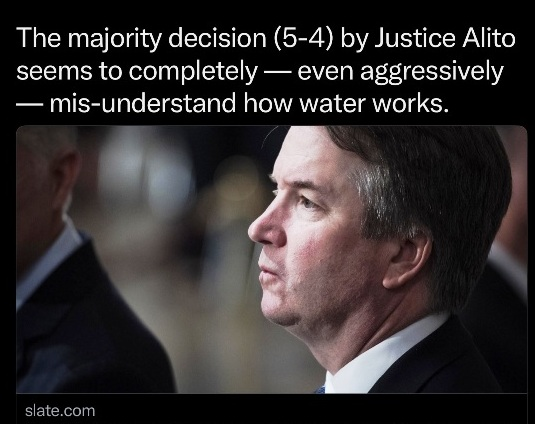File:SCOTUS decision on water protection.png
SCOTUS_decision_on_water_protection.png (535 × 424 pixels, file size: 299 KB, MIME type: image/png)
SCOTUS, the Supreme Court of the United States, acts again in the environmental arena
- The headlines in media are blunt in their news of the current court: US Supreme Court rules against EPA in wetlands regulation challenge ... The Supreme Court just narrowed protection for wetlands... The Supreme Court rolls back federal safeguards for wetlands ...
May 25, 2023
(Today, May 25th) the Supreme Court dealt a devastating blow to the nation’s wetlands by rewriting a statute the court does not like to mean something it does not mean. The court’s decision in Sackett v. EPA is one of the its most egregious betrayals of textualism in memory. Put simply: The Clean Water Act protects wetlands that are “adjacent” to larger bodies of water. Five justices, however, do not think the federal government should be able to stop landowners from destroying wetlands on their property. To close this gap between what the majority wants and what the statute says, the majority crossed through the word “adjacent” and replaced it with a new test that’s designed to give landowners maximum latitude to fill in, build upon, or otherwise obliterate some of the most valuable ecosystems on earth.
...
The law expressly protects “waters of the United States” (like rivers and lakes) as well as “wetlands adjacent” to these waters. Congress added the wetlands provision in 1977 to codify the EPA’s definition of “adjacent,” which also happens to be the actual definition: “bordering, contiguous, or neighboring.” Under that interpretation—the one Congress adopted—wetlands that neighbor a larger body of water remain protected, even if they aren’t directly connected.
Why did Congress make that choice? Because wetlands provide immense environmental benefits: They filter and purify water draining into nearby streams, rivers, and lakes. They slow down runoff into these larger bodies. And they serve as vital flood control. In other words, the Clean Water Act has to protect “adjacent” wetlands to serve its overarching goal of safeguarding the broader “waters of the United States” from pollution.
○
File history
Click on a date/time to view the file as it appeared at that time.
| Date/Time | Thumbnail | Dimensions | User | Comment | |
|---|---|---|---|---|---|
| current | 16:36, 29 May 2023 |  | 535 × 424 (299 KB) | Siterunner (talk | contribs) |
You cannot overwrite this file.
File usage
The following 3 pages use this file:
- Agriculture
- Alternative Agriculture
- Aquifers
- Biodiversity
- Biomimicry
- Climate Change
- Climate Policy
- Clean Water
- Earth Imaging
- Earth Science from Space
- Ecology Studies
- Eco-nomics
- Environmental Protection
- Florida
- Fisheries
- Green Graphics
- Green Politics
- Land Ethic
- Land Use
- Money in Politics
- Oceans
- Planet Citizens, Planet Scientists
- Resilience
- Sea-level Rise
- Sea-Level Rise & Mitigation
- Sustainability
- Sustainability Policies
- US Environmental Protection Agency
- Water
- Wastewater Treatment
- Water Pollution
- Wildlife
